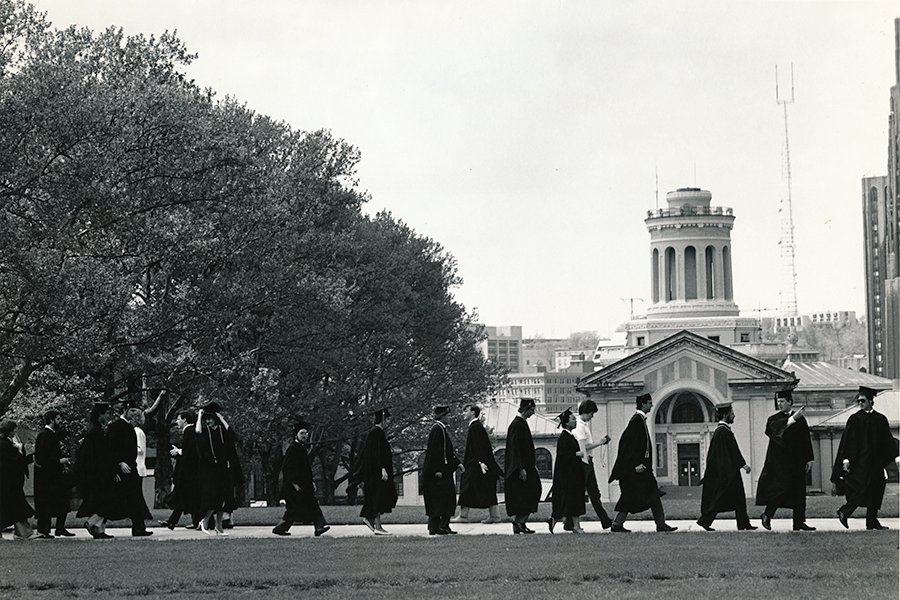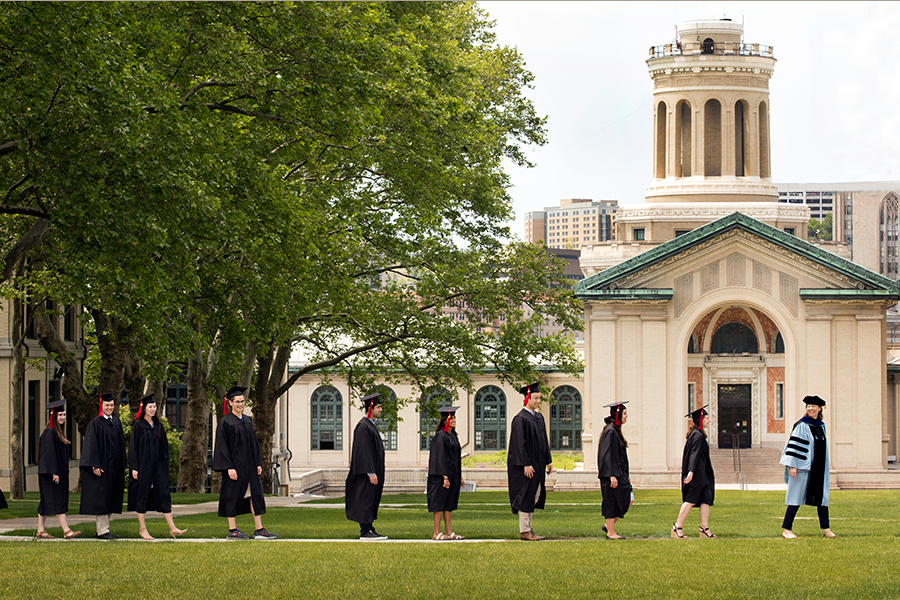History
The first students to attend the School of Applied Science and Technology were the sons of Pittsburgh's mill workers. They came to pursue a three-year diploma or a two-year certificate. Many did not have high school diplomas. No matter—Arthur Arton Hamerschlag, the Carnegie Technical Schools' first director, had no college degree.
Now, 9,000 alumni later, our undergraduate and graduate programs rank consistently among the top ten, and often among the top five, universities in the US. In 2000, the US News & World Report ranked our graduate computer engineering program number one in the country. We have established ourselves as one of the best, and we have done so within 100 years—far less time than any of our peer institutions. This is made even more remarkable by the fact that we have had a graduate research program for only 58 years.
The department has had only nine department heads in its history. This continuum of leadership has enabled us to ably and quickly respond to rapidly changing technologies.
The following is a brief timeline of the department's highlights:
1912
1940
1950
The College of Engineering and Science is nationally known for its undergraduate programs, which have embraced Doherty's Carnegie Plan of Engineering Education. Most undergraduate students come from the Western Pennsylvania region and after graduation join the ranks of the prominent local industry or the new high-tech centers on the West Coast. Carnegie Tech's reputation has begun to spread.
Teare becomes the dean of engineering in 1952.
The Department of Electrical Engineering's (EE) graduate program gains a strong reputation in magnetics and magnetic amplifiers (Leo Finzi), electromagnetics and microwave, and electrostatics and electrostatic precipitation (Gaylord Penney). The department becomes a center of fundamental understanding of physical phenomena under the leadership of Everard M. Williams, our fourth department head.
Mid-decade, the department begins to recruit faculty and graduate students in systems and controls, electronics, and communications.
By the late 1950s, the department is one of the nation's leading centers in semiconductor device research through the work of faculty Donald Feucht, Angel Jordan, Richard Longini, and Arthur Milnes. Milnes and Feucht win distinction for the department through their work in heterojunctions.
The trend toward interdisciplinary research begins. A joint program in systems and communication sciences, the foundation of the Computer Science department, draws from faculty and graduate students in electrical engineering, mathematics, psychology, and the Graduate School of Industrial Administration (now the Tepper School of Business).
The Computation Center is established and housed in Scaife Hall. Staff begin teaching programming courses.
1960
The first freshman programming course is elected by nearly half of the decade's entering class.
EE faculty participate in the new interdisciplinary Biomedical Engineering program.
The Department of Computer Science is formed in 1966, growing out of the Systems and Communications Sciences program. It is funded by an ARPA grant to the legendary Newell, Perlis, and Simon.
The opportunity for interdisciplinary research with Computer Science acts as a magnet to attract even more outstanding faculty and graduate students to EE. Computer hardware visionary Gordon Bell is hired as a joint CS/EE appointment in 1967, attracting many young faculty and grad students to the program. Significant course offerings are developed in computer hardware, software, and systems.
In 1969, Angel Jordan becomes our fifth department head.
1970
In 1971, the College of Engineering and Science is divided into two colleges: the Carnegie Institute of Technology (College of Engineering) and Mellon College of Science.
In 1972, the watchword of President Cyert's new administration is to "seek comparative advantages." EE "builds upon areas of strength" in optical processing, computer-aided design, magnetics, and solid-state electronics. Its reputation in these areas grows rapidly.
The decade is marked by selective recruitment of prominent faculty in areas such as magnetics (Mark Kryder) and computer-aided design (Steve Director, Ron Rohrer).
A 1975 national report now ranks the department eighth in the nation.
EE faculty play a prominent role in the formation of the Design Research Center, later to become the Engineering Design Research Center, an NSF Engineering Research Center.
The Center for Optical Data Processing is formed (David Casasent).
The Robotics Institute is formed in 1979, and its first graduate students come from EE.
Angel Jordan becomes the dean of engineering in 1979.
1980
Floyd Humphrey becomes our sixth department head in 1980.
The department begins construction of a 4,000-sq.-ft., class-100 cleanroom.
Steve Director becomes our seventh department head in 1982.
The department name is changed in 1983 to the Department of Electrical and Computer Engineering.
Kryder leads the formation of the Magnetics Technology Center, the preeminent university-based research center of its kind in the US.
Director leads the formation of the SRC-CMU Research Center for Computer-Aided Design, one of three in the country established by a sustaining grant from the Semiconductor Research Corporation.
The Design Research Center becomes the Engineering Design Research Center, one of the first NSF Engineering Research Centers in the country.
Sematech funds a Center of Excellence for Rapid Yield Learning (Andrzej Strojwas and Wojciech Maly) to aid the struggling US semiconductor industry.
The Magnetics Technology Center becomes the Data Storage Systems Center (DSSC) and Carnegie Mellon becomes, at the time, the only university to house two NSF Engineering Research Centers.
1990
The ECE department leads the nation into a decade of undergraduate curriculum reform. A faculty group, calling themselves the Wipe-the-Slate-Clean Committee, does just that, and the department's undergraduate curriculum becomes a bellwether for engineering curriculum reform across the US.
The CAD Center evolves into the Center for Electronic Design Automation, one of the largest international centers for the creation of EDA software tools.
Both the EDRC and DSSC Engineering Research Center contracts are renewed for another five years.
Director moves to the dean's office in 1991.
Robert White becomes ECE's eighth department head in 1993.
New faculty are hired, and there is growth in computer engineering, multimedia, and microelectromechanical systems.
The DSSC moves to its new home with state-of-the-art laboratories when Roberts Engineering Hall is built, the first new engineering building in 42 years.
In 1996, as the EDRC's 10 years of NSF funding draws to a close, the Institute for Complex Engineered Systems is formed from its infrastructure, with Pradeep Khosla as the founding director.
Pradeep Khosla becomes ECE's ninth department head in 1999.
2000 to present
Emphasis is placed on computer architecture, embedded systems, broadband telecommunications, photonics, and computer security. Since 2000, 17 new faculty have been hired.
The department receives four new endowed chairs—two corporate, one from an alumnus, and one from a friend of the university.
ECE's graduate and undergraduate programs consistently rank among the top five and top ten in the country, respectively, according to the US News & World Report.
The General Motors–Carnegie Mellon Collaborative Research Lab is formed under the leadership of Professor Ed Schlesinger. The Lab conducts interdisciplinary research on vehicle information technology at the GM R&D facilities in Warren, Michigan, and within several university departments, including ECE, Computer Science, and the Human–Computer Interaction Institute. The Lab is now codirected by Raj Rajkumar (ECE) and Patrick Popp (GM).
The Center for Silicon System Implementation (CSSI) is created out of the infrastructure of the Center for Design Automation, with Professor Larry Pileggi as its founding director. CSSI spans all aspects of research and education in design and testing of integrated circuits and systems, with particular emphasis on ultrascaled technologies.
The Center for Circuit & System Solutions (C2S2), a $19.4M MARCO Focus Center, is jointly funded by the US semiconductor industry and US Department of Defense. Directed by Professor Rob Rutenbar, C2S2 is a consortium of America's best research universities, working to develop long-range design solutions for next-generation circuits, systems built from circuits, and the software that runs on them.
Led by Professor Pradeep Khosla, a university-wide, multidisciplinary initiative known as Carnegie Mellon CyLab is launched. The multimillion-dollar public–private center is aimed at developing new technologies to secure national infrastructure and educate individuals at all levels.
The Center for Wireless and Broadband Networking (CWBN) is established under the leadership of Professor Daniel Stancil. CWBN is an interdisciplinary center for research and education in advanced networking concepts and systems, with an emphasis on industrial relevance.
Professor Ed Schlesinger steps down after eight years as associate department head to lead the DSSC. At the end of its 11-year term as an ERC, the DSSC successfully transitions to a self-sustaining research organization with continuing large-scale industrial support. Annual DSSC funding is more than $5M.
Carnegie Mellon University and Taiwanese officials establish research and educational outreach programs with the Industrial Technology Research Institute (ITRI). Research at the government-sponsored ITRI Lab@CMU focuses on circuit design and applications in communication, information technology, computer and consumer electronics, and multimedia. ITRI@CMU is directed by Professor Tsuhan Chen.
ECE hires its first director of alumni and student relations.
In Spring 2004, the first class graduates from the Athens Institute of Technology with master's degrees in information networking.
Pradeep Khosla becomes dean of engineering in the summer of 2004. Vijayakumar Bhagavatula (Kumar) serves as interim department head.
Ed Schlesinger becomes ECE's tenth department head in Spring 2005.
Professor Jimmy Zhu becomes the new director of the DSSC, with Professor James Bain as the associate director.
Jelena Kovačević becomes ECE's first female and eleventh department head in Spring 2014.
Larry Pileggi becomes ECE's twelfth department head in Spring 2019.

